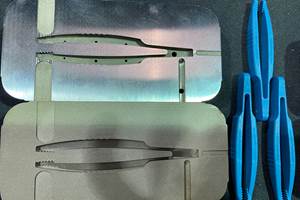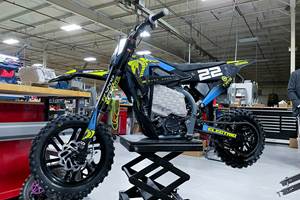Linear Comes Full Circle
The relaunched company will focus on metal 3D printing of mold inserts with conformal cooling. The timing is great, because some high-volume molders have just finished proving that this solution works.
Share
Read Next
Years ago, I heard an additive manufacturing expert dismiss the promise of conformal cooling of injection molds as a viable AM application. Tool steels are already good thermal conductors, he pointed out. Moving water lines a little closer to the mold’s surface via 3D printing can offer at best only a slight advantage. What that argument missed is the impact of even a slight advantage across molding production quantities. For a part molded in the millions, shaving 1.5 seconds from cycle time thanks to faster cooling might mean that several injection molding machines can be redeployed. Consumer products companies are aware of this possibility and pursuing it, and Linear AMS is ready to help them. Again.
The Livonia, Michigan, company recently returned to being an independent, privately held manufacturer. Two years ago, founder John Tenbusch sold majority ownership to a much larger manufacturer, Moog. Linear had started out as a mold shop, and for Moog, this original kernel of its success in metal 3D printing was the piece that didn’t fit. The larger firm wanted to focus on production parts such as aircraft components, and it decided to divest itself of moldmaking in order to do so. Lou Young, a Linear employee who had stayed on under Moog and who had helped to lead the company's mold tooling efforts, asked if he could put in an offer himself for this business. Moog said yes.
So Young called Tenbusch. The former owner was searching for his next opportunity. Young asked if he wanted to partner with him, becoming Linear’s owner all over again. Today he is CEO and Young is president of the re-launched company. Conformal-cooled mold tooling will be the focus of its AM efforts. (The company will also perform production injection molding and other manufacturing.)
But here is a funny thing: Various potential customers for that 3D-printed tooling had been waiting to commit. Though cycle time improvements are clear, would a mold insert made through laser sintering last as long one made through machining? There was one way to know. Reaching an acceptable life of 5 million shots with a 3D-printed insert took 3 years for some companies, which are now nearing the end of that validation. The testing took long enough that, conceivably, these companies might not be aware of the extent to which the provider of the tools they’ve been testing had left the market before now returning.
Here is another funny thing: Not long after Young and Tenbusch closed their deal with Moog, Tenbusch called Brandy Badami to say, “Hey, I got a job!” Badami was once his employee—senior account manager for Linear—and she mentioned that call when I recently had the chance to meet with her at Roush Industries. Today, she is Additive Manufacturing Business Development Manager with Michigan-based Roush, which is preparing to serve customers with one of the largest powder-bed AM machines available anywhere. Badami was amused to learn of the latest turn of events involving the company and person she used to work for. Yet at the same time, she is an example of why the relaunch of Linear will not involve simply putting the band back together. Badami’s knowledge and experience with AM opened the way for her to advance into a position and an opportunity she treasures. Others who worked for Linear have done much the same.
For Tenbusch, this is the legacy he loves. Committing to metal 3D printing was a strange and risky move when he began, but it turned out well in many ways, not in the least by launching careers for people who once wrestled with the technology alongside him.
In one sense, all of this is just an interesting story involving a few notable figures in AM. But in another sense, these developments illustrate just how far additive manufacturing has come. That expert who dismissed conformal cooling? He made a reasonable guess. But today we are not guessing—the business cases for AM are being proven. And today, it is not just a few companies that are working on metal 3D printing and employing the talent involved in this work. Today, that talent has spread out, because AM for many companies is no longer risky or strange, but a key capability for what they aim to do.
Related Content
3D Printing Enables Mold Shop to Rapidly Prototype Medical Parts (Video)
A case study involving Mantle’s 3D printing technology allowed moldmaker Westminster Tool to go from design to injection molded prototype medical parts in three weeks.
Read MoreNew Electric Dirt Bike Is Designed for Molding, but Produced Through 3D Printing (Includes Video)
Cobra Moto’s new all-electric youth motocross bike could not wait for mold tooling. Parts have been designed so they can be molded eventually, but to get the bike to market, the production method now is additive manufacturing.
Read More3D Printed Mold Tooling Advances in Performance With Proprietary Resin
Material improvements offer turnkey production and cost trimming with 3D printed mold tooling. A new, proprietary resin addresses the current limitations associated with 3D printing in polymer.
Read More3D Printing Molds With Metal Paste: The Mantle Process Explained (Video)
Metal paste is the starting point for a process using 3D printing, CNC shaping and sintering to deliver precise H13 or P20 steel tooling for plastics injection molding. Peter Zelinski talks through the steps of the process in this video filmed with Mantle equipment.
Read MoreRead Next
Hybrid Additive Manufacturing Machine Tools Continue to Make Gains (Includes Video)
The hybrid machine tool is an idea that continues to advance. Two important developments of recent years expand the possibilities for this platform.
Read More3D Printing Brings Sustainability, Accessibility to Glass Manufacturing
Australian startup Maple Glass Printing has developed a process for extruding glass into artwork, lab implements and architectural elements. Along the way, the company has also found more efficient ways of recycling this material.
Read More4 Ways the Education and Training Challenge Is Different for Additive Manufacturing
The advance of additive manufacturing means we need more professionals educated in AM technology.
Read More


















